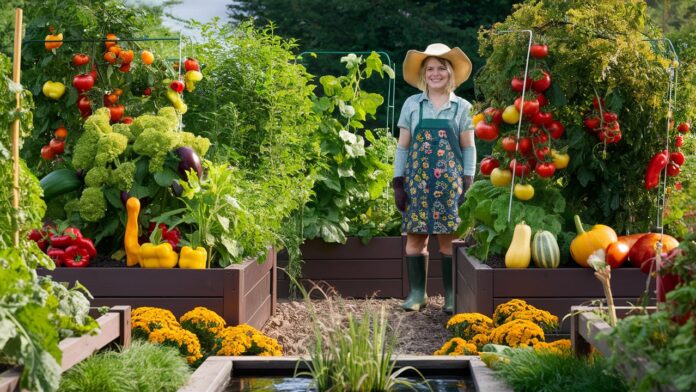Gardening is a rewarding hobby that provides a wealth of benefits, from fresh produce to mental well-being. For those with limited space or poor soil quality, raised bed gardening offers a practical and efficient solution. The image you provided showcases a beautifully organized and thriving raised bed garden, illustrating the potential of this gardening method. In this comprehensive guide, we will explore the essentials of creating a productive raised bed garden, including planning, construction, planting, and maintenance.
Why Choose Raised Bed Gardening?
1. Improved Soil Quality
Raised beds allow you to control the soil quality more effectively. You can fill the beds with a custom soil mix tailored to the needs of your plants, ensuring optimal growth conditions.
2. Better Drainage
Raised beds improve drainage, preventing waterlogging and root rot. This is especially beneficial in areas with heavy clay soils or poor natural drainage.
3. Weed and Pest Control
Elevating the garden beds helps reduce weed growth and makes it easier to manage pests. The defined borders create a barrier that can deter invasive weeds and pests.
4. Accessibility
Raised beds are easier to access for planting, weeding, and harvesting. This is particularly advantageous for individuals with mobility issues, as it reduces the need for bending and kneeling.
5. Extended Growing Season
The soil in raised beds warms up faster in the spring and cools down more slowly in the fall, extending the growing season. This allows for earlier planting and prolonged harvest periods.
Steps to Create a Raised Bed Garden
1. Planning and Design
Choose the Location
Select a location that receives at least 6-8 hours of sunlight per day. Ensure the area is level and easily accessible for watering and maintenance.
Determine the Size
Decide on the size and shape of your raised beds. Common dimensions are 4 feet wide (to allow easy access from both sides) and 6-8 feet long. The height can vary, but 12-18 inches is typical for most vegetables.
Material Selection
Choose durable, non-toxic materials for constructing the raised beds. Common options include untreated wood, composite materials, or stone. Avoid treated wood, as it may contain harmful chemicals that can leach into the soil.
2. Constructing the Raised Beds
Prepare the Site
Clear the area of weeds, grass, and debris. If the ground is uneven, level it to provide a stable base for the raised beds.
Build the Frames
Construct the frames using your chosen materials. Ensure the corners are securely fastened, and consider using corner brackets for added stability. If using wood, pre-drill holes to prevent splitting.
Line the Beds
Line the bottom of the beds with hardware cloth or landscape fabric to prevent weeds from growing up into the beds. This also helps keep pests, such as burrowing animals, from entering the garden.
3. Filling the Raised Beds
Soil Mix
Fill the beds with a high-quality soil mix. A recommended blend includes one-third topsoil, one-third compost, and one-third peat moss or coconut coir. This mix provides a balance of nutrients, drainage, and moisture retention.
Amendments
Incorporate organic amendments such as bone meal, blood meal, or worm castings to enrich the soil. These amendments provide essential nutrients and promote healthy plant growth.
4. Planting Your Raised Bed Garden
Plan the Layout
Plan the layout of your plants based on their growth habits and space requirements. Consider companion planting to maximize space and improve plant health. For example, plant tall crops like tomatoes or trellised cucumbers at the back, medium-height plants like peppers and bush beans in the middle, and low-growing crops like lettuce and carrots at the front.
Planting Process
Follow the recommended planting guidelines for each crop, paying attention to spacing, depth, and timing. Water the plants thoroughly after planting to help them establish roots.
5. Maintaining Your Raised Bed Garden
Watering
Raised beds may require more frequent watering than in-ground gardens, especially during hot, dry periods. Water deeply and consistently, aiming to keep the soil evenly moist but not waterlogged. Consider installing a drip irrigation system or soaker hoses for efficient watering.
Mulching
Apply a layer of organic mulch, such as straw or wood chips, to help retain moisture, suppress weeds, and regulate soil temperature. Mulching also improves soil structure as it decomposes.
Fertilizing
Regularly fertilize your raised bed garden to replenish nutrients. Use organic fertilizers, such as compost tea or fish emulsion, following the manufacturer’s instructions. Avoid over-fertilizing, as this can lead to nutrient imbalances and plant stress.
Pruning and Training
Prune and train plants as needed to maintain healthy growth and improve air circulation. Remove dead or diseased leaves, and stake or trellis vining crops to keep them off the ground.
Pest and Disease Management
Monitor your garden regularly for signs of pests and diseases. Employ integrated pest management (IPM) techniques, such as introducing beneficial insects, using physical barriers, and applying organic pest controls. Practice crop rotation and remove any infected plants promptly to prevent the spread of diseases.
Benefits of Raised Bed Gardening
1. Health and Wellness
Gardening promotes physical activity, reduces stress, and enhances mental well-being. Raised bed gardening is especially beneficial for those with physical limitations, allowing them to engage in gardening with greater ease.
2. Fresh, Nutritious Produce
Growing your own vegetables ensures access to fresh, nutrient-dense produce. Homegrown vegetables often taste better and are free from harmful pesticides and chemicals.
3. Environmental Sustainability
Raised bed gardening promotes sustainable practices, such as composting, water conservation, and organic pest management. It also reduces the need for chemical fertilizers and pesticides, benefiting the environment.
4. Educational Opportunities
Raised bed gardening provides valuable learning experiences for both children and adults. It teaches essential skills in plant care, ecology, and sustainable living, fostering a deeper connection with nature.
5. Community Building
Raised bed gardens can be a focal point for community involvement, bringing people together to share knowledge, resources, and produce. Community gardens often enhance neighborhood cohesion and provide a sense of shared purpose.
Tips for Successful Raised Bed Gardening
1. Start Small
If you’re new to raised bed gardening, start with one or two beds to gain experience and understand the specific needs of your plants. Expand gradually as you become more comfortable.
2. Choose the Right Plants
Select plants that are well-suited to your climate, soil conditions, and available space. Opt for disease-resistant varieties to reduce the risk of crop failure.
3. Rotate Crops
Practice crop rotation to prevent soil depletion and reduce the buildup of pests and diseases. Avoid planting the same family of crops in the same spot year after year.
4. Keep Records
Maintain a garden journal to track planting dates, growth progress, and any issues that arise. This information will help you make informed decisions and improve your gardening practices over time.
5. Enjoy the Process
Gardening is a journey of learning and discovery. Embrace the process, enjoy the beauty of your garden, and savor the fruits of your labor.
Conclusion
Raised bed gardening is a versatile and rewarding method that offers numerous benefits, from improved soil quality and better drainage to increased accessibility and extended growing seasons. By following the steps outlined in this guide, you can create a productive and beautiful raised bed garden, even in small or challenging spaces. Whether you’re a seasoned gardener or a beginner, raised bed gardening provides an excellent opportunity to grow fresh, nutritious produce, enhance your environment, and enjoy the many physical and mental health benefits of gardening. Embrace this sustainable and efficient gardening method to transform your outdoor space and reap the rewards of your efforts.



